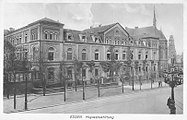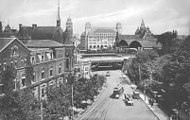Huyssens Foundation
| Huyssens Foundation | |
|---|---|
| Sponsorship | Clinics Essen-Mitte Evang. Huyssens Foundation / Knappschaft GmbH |
| place | Food - Huttrop |
| state | North Rhine-Westphalia |
| Country | Germany |
| Coordinates | 51 ° 26 '30 " N , 7 ° 1' 49" E |
| management | Horst Defren |
| beds | 696 |
| Employee | approx. 780 |
| including doctors | approx. 222 |
| areas of expertise | Internal medicine , surgery , hematology / oncology , gynecological oncology, psychiatry , urology , senology , anesthesiology , radiology |
| founding | 1854 |
| Website | Huyssens Foundation |
The Evangelical Huyssens Foundation is a hospital in the Essen district of Huttrop . The Academic Teaching Hospital of the University of Duisburg-Essen has been a member of the international and German network of health promoting hospitals of the WHO since October 1996 . It is located in the Moltkeviertel, which is interesting in terms of urban planning and architecture .
history
First hospital in 1854
On December 25, 1852, the Lord Mayor of Essen, Heinrich Arnold Huyssen, signed a deed of donation in which he donated land and money for the construction of a hospital to the Protestant parish of Essen-Altstadt. There was also a large number of small donations that supported the construction. In 1853, the foundation stone for the first Protestant hospital in Essen was laid on today's Huyssenallee in front of the Kettwiger Tor . It was opened with the name Huyssens-Stift in October 1854. Huyssen hired Carl Wilhelm Theodor Freyse as the architect , who also built Huyssen's house on Burgplatz and Essen's second town hall . The hospital accommodated 30 adults and six children. In the course of the ever faster advancing industrialization from the middle of the 19th century and the resulting increase in population due to immigrant workers, an extension was built in 1863/1864 at Huyssen's expense, whereby the house received its first water pipe. As the founder of the clinic, Huyssen became an honorary voting member of the Board of Trustees for life. The industrialist Alfred Krupp also became an honorary member of the Board of Trustees. He and other members of the Krupp family were among the largest donors to the Huyssens Foundation until the 1940s. Gustav Krupp von Bohlen und Halbach gave, among other things, the organ that is still played today in the hospital chapel on the first floor. On a donation account at the Sparkasse that had been set up by Pastor Wächtler , an unexpected number of large donations from the Protestant community were received. From this, among other things, eight free beds for destitute citizens were set up in the hospital, as well as normal loans were given to Essen citizens, whose interest income flowed back into the foundation. The Essen merchant and industrialist Friedrich Grillo , who was a member of the Board of Trustees from 1864 to 1883 as a city councilor, then until 1888 as a private entrepreneur , also appeared through generous donations . In addition, Grillo carried out the first revisions of the annual accounts, had a garden wall built in 1866 and renewed the kitchen and entrance gate in 1873. After his death, Grillo's widow, Wilhelmine Grillo née. Born , regularly for the expansion of medical equipment. Among other things, she donated the first X-ray machine in 1899 and bequeathed another 100,000 marks to the Huyssens Foundation in her will in 1904 . Furthermore, the city councilor Heinrich Carl Sölling supported the Huyssens Foundation with 75,000 marks. The city councilor and Essen entrepreneur Richard Bömke was one of the foundation's board members .
In 1891 it was built on and rebuilt again. The money for this came, among other things, from the proceeds of the bazaar, which had been organized by the women's committee, chaired by Pastor Wächtler , in the Herberge zur Heimat from December 4th to 8th, 1899. In 1910 there were already plans for a completely new hospital to be built elsewhere for capacity reasons, but these had to be suspended due to the First World War and the Battle of the Ruhr in 1923/1924. After the house had to be closed completely due to financial difficulties in 1923, the plans for a new building were taken up again in 1927.
During the Battle of the Ruhr in 1923/1924, Baroness Anna Linder bought the Huyssens Foundation without further ado to protect it from the threat of expropriation by the occupying power. Then she returned the clinic to the community. Anna Linder was the head of the Swedish Aid Organization based in the Huyssens Foundation. It protected the house from the threat of closure in these times of food, clothing and coal shortages.
From 1928 Karl Scheele was head of surgery.
Huyssens Foundation around 1917, in the background the Hotel Handelshof and the main train station , on the right the cemetery at Kettwiger Tor
New building from 1934 to 1936
The clinic's capacities were still insufficient. On May 18, 1931, there was a building application with plans for a preliminary draft, which already showed the floor plan of a double type with a central entrance area and the chapel at today's location. The groundbreaking ceremony did not take place until March 31, 1934 due to the tight budget of the city of Essen, so that the shell was up to the third floor at the end of the year. On December 15, 1936, the new hospital with eleven specialist departments and 475 beds was moved to the new location on what was then the outskirts of the city in Henricistraße. The design comes from the Wuppertal architect Carl Conradi , the construction was supervised by the Essen architect Paul Dietzsch. The Evangelical Church Community Essen-Altstadt acted as the client. The three-wing Bauhaus style building enclosed a park and offered hospital rooms with balconies on the south side.
The Huyssens Foundation was converted into a non-profit company with limited liability in 1975. Between 1987 and 1992 the north and east wings were renovated. Shortly afterwards, the house was expanded to include a restaurant, a reclining access and a psychiatric acute ward, the entrance area was redesigned in 1995 and a central emergency room was added in 1997. At this time, a radiological practice moved into the former nurses' home.
In 1995 the Huyssens Foundation merged with the Essen Knappschaftskrankenhaus in Steele to form the Essen-Mitte Clinics , which are sponsored by the Essen-Mitte Church District, the Federal Miners' Association in Bochum and the Association of Friends and Supporters of the Evangelical Hospital Huyssens Foundation .
In 2011 the hospital was expanded to include a building with 90 beds for private patients. The restoration of the aging old building should then take place. The modernization of the old building turned out to be more time-consuming and more disruptive for the patients than initially expected, which is why it was decided to build a four-story 400-bed building over part of the old hospital park, then to move the patients from the old building there and the old one Core and modernize the hospital.
Hospital chapel

On April 11, 1937, during the Nazi era , the hospital chapel was inaugurated with a simple church service. The city of Essen entered them in their list of monuments on February 13, 2020. Until 2019, for example, it had a ceiling decoration with swastika elements in the ribbon decoration. The architect Carl Conradi drafted his plans in 1935 without this ceiling construction. So far it is not possible to determine when and by whom the Nazi symbols came into the chapel. The chapel ceiling is currently removed.
A central convertible altar by Rudolf Schäfer with an aryanized, blond and blue-eyed Jesus Christ has been preserved, but was removed from the chapel in 1994 and stored.
Carl Bringmann (1878–1962) designed the windows of the chapel so that they were installed by the Coburg art glassworks Carl Bringmann & Kurt Schmidt. The six windows on the left of the chapel depict the theme of Christ's Word ; in detail the Sermon on the Mount, the following of Christ, the prodigal son, the good Samaritan, the good shepherd and the crucifixion group. The six windows on the right side of the chapel show the theme of Christ's deed ; in detail the awakening of Lazarus, the calming of the sea, the child friend, the healing of the lame at the lake, the healing of the blind and the savior of the laborious and burdened.
An original organ from the Ludwigsburg organ builder Walcker is still in the chapel.
The hospital today
The Huyssens-Stift has nine operating theaters and the following specialist departments:
- Clinic for General Internal Medicine and Gastroenterology
- Clinic for Surgery and Center for Minimally Invasive Surgery
- University Clinic for Oral and Maxillofacial Surgery
- Clinic for Internal Medicine IV: Internal Oncology / Hematology
- Clinic for Psychiatry, Psychotherapy and Addiction Medicine
- Clinic for Urology, Pediatric Urology and Urological Oncology
- Senology Clinic and Breast Center
- Clinic for Gynecological Oncology (from 2011)
- Clinic for Anaesthesiology, Intensive Care and Pain Therapy
- Clinic for Diagnostic and Interventional Radiology
In 2003, the state of North Rhine-Westphalia funded the construction of examination and treatment wing II, with four new operating theaters, an intensive care unit and an outpatient clinic, which began operations at the end of 2005. At the beginning of 2005, the Essen Outpatient Tumor Center (ATZ) went into operation, a separate building with access to the main building.
The Clinic for Internal Medicine IV in the Huyssens-Stift, and thus the internal oncology and hematology with a center for palliative medicine, was appointed a Designated Center of Integrated Oncology and Palliative Care by the European Society for Medical Oncology (ESMO) in December 2004 . Of the eight clinics appointed for this purpose across Europe, the Huyssens Stift took first place.
literature
- Anette Hinze: A blessed gift. 150 years of the Huyssens Foundation. Klartext-Verlag, Essen 2004, ISBN 3-89861-340-2 .
- Initiativkreis Ruhrgebiet: Clinic Guide Rhein Ruhr 2010/2011 . Klartext, Essen 2010, ISBN 978-3-8375-0209-1 .
- Opening ceremony of the Huyssens Foundation, Essen, 1937
Web links
Individual evidence
- ↑ a b c d Quality Report 2016
- ^ A b c d e excerpt from the list of monuments of the city of Essen, hospital chapel ; accessed on August 19, 2020.
- ↑ DerWesten.de from July 5, 2013: My friend's family tree ; accessed on May 7, 2015.
- ↑ Berger Bergmann, Peter Brdenk (Ed.): Architecture in Essen 1900–1960. Klartext Verlag, 2012, ISBN 978-3-8375-0246-6 , p. 140.
- ↑ Claudia Pospieszny: Huyssenstift builds 90-bed house for privately insured persons. on www.derwesten.de, June 6, 2011.
- ↑ Claudia Pospieszny: Huyssenstift builds a new 400 bed house in Essen. on www.derwesten.de, June 9, 2013.
- ↑ See Initiativkreis Ruhrgebiet: Klinik-Führer Rhein Ruhr 2010/2011. 2010, pp. 264-268.



